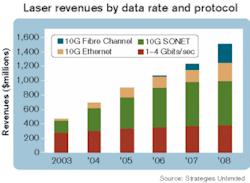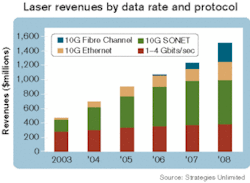Promising sources of revenue: 10-Gbit/sec long-wave laser market
A funny thing about markets is that the mood of an industry doesn't depend so much on the level of revenues, but rather the direction of the revenues over time. The general mood in the communications industry is improving this year as equipment orders grow in number and size. Yet ironically, the overall sales level is still well below 2001 and even 2002, when despair engulfed the entire industry.
Growth is returning, but the question remains, what segments will grow best in an industry that has returned to its more conservative, humble roots? Traffic is increasing, in some cases rapidly, and threatening to burst networks at the seams unless carriers relieve the pressure by installing new equipment. But will there be growth in the money to pay for new equipment, or will the industry simply have to do more with the same level of capital expenditures (capex) it is spending now?
Customer spending and the share of revenues on wireline services is still declining quarter over quarter, as wireless and cable television providers continue to gain market share. Some of that is due to price competition among wireline carriers, and some is due to the migration of retail customers to wireless and multiple-system operators. Granted, these same providers are also customers of wireline backbone services and will drive demand on the backbone still higher. But the fact remains that wireline revenues have been declining, not growing. And from these revenues comes the money to buy new capital equipment.
Wireline revenues will eventually recover, and so will capex. But long-term growth will be limited to 5–10% per year. That is slightly more than the annual growth in the gross domestic product and in line with historical trends for a mature, regulated industry. Where does that leave the components business?
One of the more promising component segments is the 10-Gbit/sec laser transmitter market, particularly at long wavelengths. This market classification refers to the laser as it is installed into a system, whether as a transponder, a transceiver, or in the form of a butterfly or other discrete package. We expect compounded revenue growth of 30% per year in the 10-Gbit/sec long-wavelength laser market through 2008—but it has been a long time coming.
Sales volumes of lasers scale greatly with data rate, reach, and wavelength. There are several million 850-nm Gigabit Ethernet (GbE) transceivers manufactured for enterprise systems, but the prices are in the tens of dollars. In contrast, prices for 10-GbE transceivers were well over $1,000 last year, but the sales were still in the noise level. The problem up to now has been that 10-Gbit/sec laser sales have been confined to telecommunications applications, which were devastated when the bubble broke.
The growth in 10-Gbit/sec transceivers will come strongest first from telecom systems using SONET or SDH protocols. Where WDM is used, the products are specified to the appropriate ITU wavelength, either as continuous wave or modulated devices. As a rule, telecom volumes are smaller than in enterprise networks, but the telecom world has worked with 10-Gbit/sec systems for several years.
While 10-Gbit/sec transceivers for Ethernet networks will grow strongly this year to about 50,000 units, they will make a more substantial impact next year. These transceivers usually are specified for shorter distances than telecom products, and we expect significant volumes as enterprises continue to expand their campus networks. Multimode (MM) 850-nm lasers are insufficient at 10 Gbits/sec over MM fiber beyond a few meters, opening the market for novel long-wavelength solutions like LX4 products as well as devices using electronic dispersion compensation.
Eventually, the storage industry will migrate to 10-Gbit/sec Fibre Channel transceivers, which is expected to strongly impact revenues by 2008. (Here, we consider a hypothetical 8-Gbit/sec standard as another form of a "10-Gbit/sec" product.) Most people don't associate Fibre Channel with long-wavelength transmission, but more and more systems will expand beyond the very short distances and MM lasers that are more typical in these applications. The migration to 10 Gbits/sec strains the performance that MM lasers can offer, and long-wavelength lasers provide a reliable and competitive solution.
The wild card in the 10-Gbit/sec laser market is pricing. Prices have been falling precipitously in the last few years. Startup companies are boasting that their innovations will make high-end products yet more manufacturable. If even a few of the many startups actually execute on their targets, we can expect prices to continue to fall, limiting the upside of revenues. Trends in form factors also complicate pricing, with the industry moving away from discrete products toward full-blown transponders (at higher value) and further still toward small-form-factor transceivers.As if that isn't enough, we counted over 100 companies supplying some type of laser product at the OFC Conference in February. The coming growth is clearly not enough for so many players. Customers all indicate that they want to work with a smaller, not larger, number of suppliers. Meanwhile, these products are still very difficult to manufacture, and we don't know who will be able to execute on their promises and who will not.
We assume that innovation and competition will continue to drive down prices, but customers will begin to pay a premium to the suppliers that can deliver on their promises. The premium and a continual shift to more advanced products will slow the fall of prices, helping suppliers.
Still, there's the question, how much growth can suppliers expect? The 10-Gbit/sec transceiver segment at least will finally come into its own. But many companies won't find solace when they have to share sales with the great number of other suppliers. In that sense, the recovery will not be behind us until we see which suppliers are left standing, perhaps not for another year, or more likely two years. ..
Tom Hausken is the director of optical components research at Strategies Unlimited (Mountain View, CA), a research division of PennWell, publisher of Lightwave. He can be reached via the company's Website, www.strategies-u.com.

